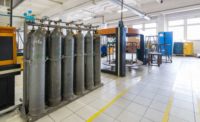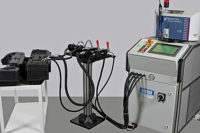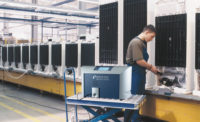
The finished column is loaded onto a truck. Source: Titan Metal Fabricators Inc.
Titan Metal Fabricators Inc. (Camarillo, CA), a designer and manufacturer of heat exchangers, pressure vessels and related products for the steel, pharmaceutical and chemical industries, was commissioned to construct a 90-foot-long, 5-foot-diameter pressurized column for a customer. The column was to be used for the containment of pressurized hydrochloric acid at a high temperature. Before the column could be delivered to the field, it had to undergo leak testing that would verify its conformity to applicable requirements of the American Society of Mechanical Engineers (ASME) and stringent customer demands.
To this end, Titan’s Quality Manager Jim Ramirez drew upon his 20-year relationship with Helium Leak Testing Inc. (HLT, Northridge, CA), a provider of helium leak detection systems and services. “Helium Leak Testing Inc. has been in business for more than 40 years,” says Ramirez. “Their expertise and reputation in this specialized field of testing in the Southern California area are well known.”
Said to be the largest of its kind, the single-piece column is made from carbon steel, and includes an interior 0.020-inch tantalum liner to protect against the corrosive effects of the acid. The single-piece construction of the column was essential in order to provide a continuous surface for the interior acid-resistant liner. Therefore, the column had to be constructed without body flanges, which would have allowed the column to be shipped in shorter sections and then bolted together in the field. “There were plenty of nozzles and manway openings but no girth body flanges,” says Ramirez. “The tantalum lining has to be leak proof; therefore, it is constructed as a separated single chamber also.” Because of the tantalum liner’s function as a buffer between the acid and the steel column, it was imperative that no leaks existed in its welds, a defect that would result in the corrosion of the column.
The column was designed with the final testing in mind. The tantalum liner was accomplished through the installation of individual sheets formed and fitted into sections. Using a mass spectrometer helium leak detector (MSLD), each section was tested as fabrication proceeded. The MSLD was connected to test ports located along the entire outer surface of the column, allowing access to the annulus area between the lining and inner vessel wall. With the steel column serving as a vacuum chamber, the annulus area of the tantalum liner was put under vacuum, and the tantalum liner welds inside the column were sprayed with helium. The MSLD served as an integral part of the vacuum, and leaks in the welds were indicated as parts per million of helium entering the MSLD.
The testing of several hundred feet of complex welding revealed very few leaks. Those found were temporarily sealed so each section could be completed and then repaired for the retest. After the tantalum lining of the entire column had passed the helium leak test, the column was pressure tested as required by ASME, and the lining was then helium leak tested a final time to ensure that it remained leak free. The lining successfully passed the test and the column was ready to ship to the customer. “It is a tremendous advantage when a manufacturer can call on a company with the experience and expertise that HLT offers in this specialized field of testing,” concludes Ramirez.
- Helium Leak Testing Inc.
(818) 349-5690
www.heliumleaktesting.com
Reply 709


